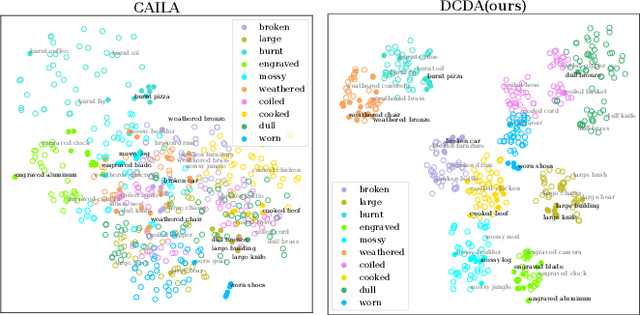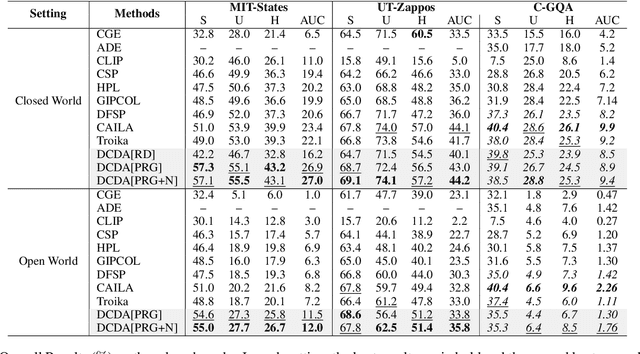Jiaoyan Chen
Department of Computer Science, University of Oxford
Evaluating Knowledge Graph Based Retrieval Augmented Generation Methods under Knowledge Incompleteness
Apr 07, 2025Abstract:Knowledge Graph based Retrieval-Augmented Generation (KG-RAG) is a technique that enhances Large Language Model (LLM) inference in tasks like Question Answering (QA) by retrieving relevant information from knowledge graphs (KGs). However, real-world KGs are often incomplete, meaning that essential information for answering questions may be missing. Existing benchmarks do not adequately capture the impact of KG incompleteness on KG-RAG performance. In this paper, we systematically evaluate KG-RAG methods under incomplete KGs by removing triples using different methods and analyzing the resulting effects. We demonstrate that KG-RAG methods are sensitive to KG incompleteness, highlighting the need for more robust approaches in realistic settings.
Supposedly Equivalent Facts That Aren't? Entity Frequency in Pre-training Induces Asymmetry in LLMs
Mar 28, 2025Abstract:Understanding and mitigating hallucinations in Large Language Models (LLMs) is crucial for ensuring reliable content generation. While previous research has primarily focused on "when" LLMs hallucinate, our work explains "why" and directly links model behaviour to the pre-training data that forms their prior knowledge. Specifically, we demonstrate that an asymmetry exists in the recognition of logically equivalent facts, which can be attributed to frequency discrepancies of entities appearing as subjects versus objects. Given that most pre-training datasets are inaccessible, we leverage the fully open-source OLMo series by indexing its Dolma dataset to estimate entity frequencies. Using relational facts (represented as triples) from Wikidata5M, we construct probing datasets to isolate this effect. Our experiments reveal that facts with a high-frequency subject and a low-frequency object are better recognised than their inverse, despite their logical equivalence. The pattern reverses in low-to-high frequency settings, and no statistically significant asymmetry emerges when both entities are high-frequency. These findings highlight the influential role of pre-training data in shaping model predictions and provide insights for inferring the characteristics of pre-training data in closed or partially closed LLMs.
RegD: Hierarchical Embeddings via Distances over Geometric Regions
Jan 29, 2025



Abstract:Hierarchical data are common in many domains like life sciences and e-commerce, and their embeddings often play a critical role. Although hyperbolic embeddings offer a grounded approach to representing hierarchical structures in low-dimensional spaces, their utility is hindered by optimization difficulties in hyperbolic space and dependence on handcrafted structural constraints. We propose RegD, a novel Euclidean framework that addresses these limitations by representing hierarchical data as geometric regions with two new metrics: (1) depth distance, which preserves the representational power of hyperbolic spaces for hierarchical data, and (2) boundary distance, which explicitly encodes set-inclusion relationships between regions in a general way. Our empirical evaluation on diverse real-world datasets shows consistent performance gains over state-of-the-art methods and demonstrates RegD's potential for broader applications beyond hierarchy alone tasks.
MINTQA: A Multi-Hop Question Answering Benchmark for Evaluating LLMs on New and Tail Knowledge
Dec 22, 2024Abstract:Large language models (LLMs) have demonstrated impressive capabilities in various reasoning tasks but face significant challenges with complex, knowledge-intensive multi-hop queries, particularly those involving new or long-tail knowledge. Existing benchmarks often fail to fully address these challenges. To bridge this gap, we introduce MINTQA (Multi-hop Question Answering on New and Tail Knowledge), a comprehensive benchmark to evaluate LLMs' capabilities in multi-hop reasoning across four critical dimensions: question handling strategy, sub-question generation, retrieval-augmented generation, and iterative or dynamic decomposition and retrieval. MINTQA comprises 10,479 question-answer pairs for evaluating new knowledge and 17,887 pairs for assessing long-tail knowledge, with each question equipped with corresponding sub-questions and answers. Our systematic evaluation of 22 state-of-the-art LLMs on MINTQA reveals significant limitations in their ability to handle complex knowledge base queries, particularly in handling new or unpopular knowledge. Our findings highlight critical challenges and offer insights for advancing multi-hop reasoning capabilities. The MINTQA benchmark is available at https://github.com/probe2/multi-hop/.
Atomic Fact Decomposition Helps Attributed Question Answering
Oct 22, 2024



Abstract:Attributed Question Answering (AQA) aims to provide both a trustworthy answer and a reliable attribution report for a given question. Retrieval is a widely adopted approach, including two general paradigms: Retrieval-Then-Read (RTR) and post-hoc retrieval. Recently, Large Language Models (LLMs) have shown remarkable proficiency, prompting growing interest in AQA among researchers. However, RTR-based AQA often suffers from irrelevant knowledge and rapidly changing information, even when LLMs are adopted, while post-hoc retrieval-based AQA struggles with comprehending long-form answers with complex logic, and precisely identifying the content needing revision and preserving the original intent. To tackle these problems, this paper proposes an Atomic fact decomposition-based Retrieval and Editing (ARE) framework, which decomposes the generated long-form answers into molecular clauses and atomic facts by the instruction-tuned LLMs. Notably, the instruction-tuned LLMs are fine-tuned using a well-constructed dataset, generated from large scale Knowledge Graphs (KGs). This process involves extracting one-hop neighbors from a given set of entities and transforming the result into coherent long-form text. Subsequently, ARE leverages a search engine to retrieve evidences related to atomic facts, inputting these evidences into an LLM-based verifier to determine whether the facts require expansion for re-retrieval or editing. Furthermore, the edited facts are backtracked into the original answer, with evidence aggregated based on the relationship between molecular clauses and atomic facts. Extensive evaluations demonstrate the superior performance of our proposed method over the state-of-the-arts on several datasets, with an additionally proposed new metric $Attr_{p}$ for evaluating the precision of evidence attribution.
TransBox: EL++-closed Ontology Embedding
Oct 18, 2024Abstract:OWL (Web Ontology Language) ontologies, which are able to represent both relational and type facts as standard knowledge graphs and complex domain knowledge in Description Logic (DL) axioms, are widely adopted in domains such as healthcare and bioinformatics. Inspired by the success of knowledge graph embeddings, embedding OWL ontologies has gained significant attention in recent years. Current methods primarily focus on learning embeddings for atomic concepts and roles, enabling the evaluation based on normalized axioms through specially designed score functions. However, they often neglect the embedding of complex concepts, making it difficult to infer with more intricate axioms. This limitation reduces their effectiveness in advanced reasoning tasks, such as Ontology Learning and ontology-mediated Query Answering. In this paper, we propose EL++-closed ontology embeddings which are able to represent any logical expressions in DL via composition. Furthermore, we develop TransBox, an effective EL++-closed ontology embedding method that can handle many-to-one, one-to-many and many-to-many relations. Our extensive experiments demonstrate that TransBox often achieves state-of-the-art performance across various real-world datasets for predicting complex axioms.
MKGL: Mastery of a Three-Word Language
Oct 10, 2024



Abstract:Large language models (LLMs) have significantly advanced performance across a spectrum of natural language processing (NLP) tasks. Yet, their application to knowledge graphs (KGs), which describe facts in the form of triplets and allow minimal hallucinations, remains an underexplored frontier. In this paper, we investigate the integration of LLMs with KGs by introducing a specialized KG Language (KGL), where a sentence precisely consists of an entity noun, a relation verb, and ends with another entity noun. Despite KGL's unfamiliar vocabulary to the LLM, we facilitate its learning through a tailored dictionary and illustrative sentences, and enhance context understanding via real-time KG context retrieval and KGL token embedding augmentation. Our results reveal that LLMs can achieve fluency in KGL, drastically reducing errors compared to conventional KG embedding methods on KG completion. Furthermore, our enhanced LLM shows exceptional competence in generating accurate three-word sentences from an initial entity and interpreting new unseen terms out of KGs.
CoTKR: Chain-of-Thought Enhanced Knowledge Rewriting for Complex Knowledge Graph Question Answering
Sep 29, 2024



Abstract:Recent studies have explored the use of Large Language Models (LLMs) with Retrieval Augmented Generation (RAG) for Knowledge Graph Question Answering (KGQA). They typically require rewriting retrieved subgraphs into natural language formats comprehensible to LLMs. However, when tackling complex questions, the knowledge rewritten by existing methods may include irrelevant information, omit crucial details, or fail to align with the question's semantics. To address them, we propose a novel rewriting method CoTKR, Chain-of-Thought Enhanced Knowledge Rewriting, for generating reasoning traces and corresponding knowledge in an interleaved manner, thereby mitigating the limitations of single-step knowledge rewriting. Additionally, to bridge the preference gap between the knowledge rewriter and the question answering (QA) model, we propose a training strategy PAQAF, Preference Alignment from Question Answering Feedback, for leveraging feedback from the QA model to further optimize the knowledge rewriter. We conduct experiments using various LLMs across several KGQA benchmarks. Experimental results demonstrate that, compared with previous knowledge rewriting methods, CoTKR generates the most beneficial knowledge representation for QA models, which significantly improves the performance of LLMs in KGQA.
Cross-composition Feature Disentanglement for Compositional Zero-shot Learning
Aug 19, 2024



Abstract:Disentanglement of visual features of primitives (i.e., attributes and objects) has shown exceptional results in Compositional Zero-shot Learning (CZSL). However, due to the feature divergence of an attribute (resp. object) when combined with different objects (resp. attributes), it is challenging to learn disentangled primitive features that are general across different compositions. To this end, we propose the solution of cross-composition feature disentanglement, which takes multiple primitive-sharing compositions as inputs and constrains the disentangled primitive features to be general across these compositions. More specifically, we leverage a compositional graph to define the overall primitive-sharing relationships between compositions, and build a task-specific architecture upon the recently successful large pre-trained vision-language model (VLM) CLIP, with dual cross-composition disentangling adapters (called L-Adapter and V-Adapter) inserted into CLIP's frozen text and image encoders, respectively. Evaluation on three popular CZSL benchmarks shows that our proposed solution significantly improves the performance of CZSL, and its components have been verified by solid ablation studies.
OWL2Vec4OA: Tailoring Knowledge Graph Embeddings for Ontology Alignment
Aug 12, 2024Abstract:Ontology alignment is integral to achieving semantic interoperability as the number of available ontologies covering intersecting domains is increasing. This paper proposes OWL2Vec4OA, an extension of the ontology embedding system OWL2Vec*. While OWL2Vec* has emerged as a powerful technique for ontology embedding, it currently lacks a mechanism to tailor the embedding to the ontology alignment task. OWL2Vec4OA incorporates edge confidence values from seed mappings to guide the random walk strategy. We present the theoretical foundations, implementation details, and experimental evaluation of our proposed extension, demonstrating its potential effectiveness for ontology alignment tasks.
 Add to Chrome
Add to Chrome Add to Firefox
Add to Firefox Add to Edge
Add to Edge